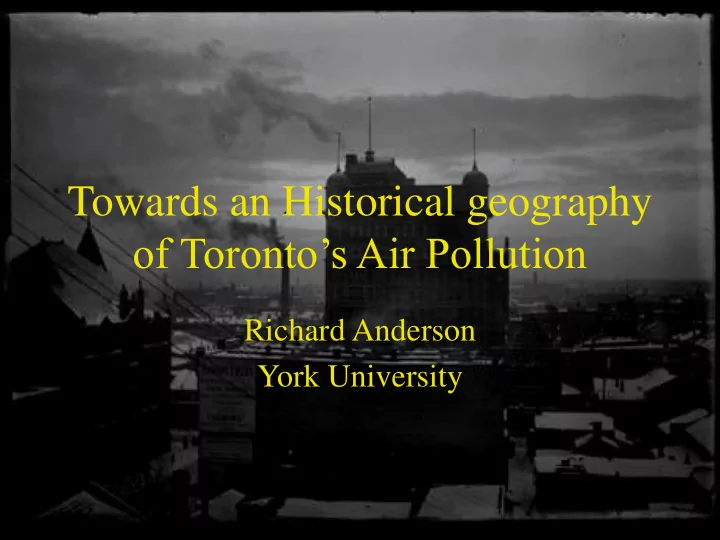

Towards an Historical geography of Toronto’s Air Pollution Richard Anderson York University
1900s
Bay-Adelaide 1915
1928
1922
1923
1948
1959
Urban Air Pollution • A key attribute of urban environmental health • Obviously a widespread problem in historic cities • Limited examination by environmental historians – Few maps • Almost nothing done by historical geographers
A key problem • How do you map historic air pollution? • Soil & sediment sampling – Expensive, technical …
Test #1 • Does the visibility pattern match industrial land use, likely the biggest source of smoke? – Compare 1920s visibility with industrial land use in 1923 Goads insurance atlas
Test #2 • Does the visibility pattern match newspaper references to smoke issues? – Content analysis of 1920s newspaper coverage
Test #3 • Does the visibility pattern connect to urban respiratory health? – Compare visibility patterns to infant respiratory mortality – Bronchitis & pneumonia appear to be the key disease categories – Infants likely to be the most spatially sensitive
1903
1906
1909-10
1922
Toronto: Pneumonia and Broncho-Pneumonia Mortality (deaths/000 people) 40.00 35.00 30.00 25.00 20.00 15.00 10.00 5.00 0.00 Jan 1876 Jan 1879 Jan 1882 Jan 1885 Jan 1888 Jan 1891 Jan 1894 Jan 1897 Jan-00 Jan-03 Jan-06 Jan-09 Jan-12 Jan-15 Jan-18 Jan-21 Jan-24 Jan-27 Jan-30 Jan-33 Jan-36
Toronto: Respiratory Mortality 1903 CDR % due to Pneumonia & Bronchitis 25 20 15 10 5 0 Jan-03 Feb-03 Mar-03 Apr-03 May-03 Jun-03 Jul-03 Aug-03 Sep-03 Oct-03 Nov-03 Dec-03
Toronto 1903: Bronchitis and Pneumonia as % of deaths 25 20 15 All Infants 10 5 0 Jan- Feb- Mar- Apr- May- Jun- Jul-03 Aug- Sep- Oct- Nov- Dec- 03 03 03 03 03 03 03 03 03 03 03
Test #4 • How do the visibility patterns compare with urban social geography?
• 1910
• 1925
Test #4 • Do wealthy people show a tendency to avoid the smoke?
1905
1915
1905
1915
1925
Test #4 • Some tendency for wealth to avoid smoke • But other processes are at work too
A Dynamic Pattern over Time • Tests of the visual technique are possible in C20th • Difficult for C19th
Changes over Time • Visibility mapping suggests highly dynamic patterns over space and time • Can we measure the temporality of Toronto’s air pollution?
Temporality • Existing studies of historic urban air pollution are very weak on spatial patterns and variation over time.
Toronto Combustion 000 tonnes CE 7000 6000 5000 Coal 4000 Wood Incineration 3000 Petroleum 2000 1000 0 1820 1840 1860 1880 1900 1920 1940 1960
Toronto Air Pollution Mean visibility (metres) vs estimated particulate emissions from coal burning 1400 1200 1000 800 Mean vis tpm/000 600 400 200 0 1900 1910 1920 1930 1940 1950 1960 1970
Some Results • There are signs that photo analysis is able to reveal both the spatiality and the temporality of historic urban air pollution.
Some Results • Measuring historic urban air pollution may help us understand the spatiality and temporality of – Urban disease, mortality, demography – Urban social geography
Recommend
More recommend